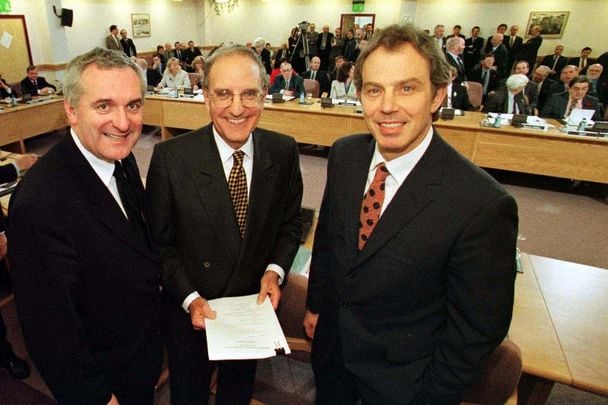The Good Friday Agreement, which can be read in full here, has been the main source of peace in Northern Ireland since its signing.
The Good Friday Agreement - also known as the Belfast Agreement - was signed on April 10, 1998 following years of negotiations.
After it was signed, the agreement was put to voters in two referendums - one in Ireland and one in Northern Ireland - on May 22, 1998.
The following day, May 23, it emerged that the Good Friday Agreement found a majority of support in both referendums - 71% supported it in Northern Ireland while 94% supported it in Ireland.
It subsequently came into law in December 1999 and is now part of the Irish Constitution.
Halting most of the violent conflict in the region, the Good Friday Agreement was the most important and enduring development of the Northern Irish peace process.
The two main political parties to the Agreement were the Ulster Unionist Party (UUP), led by David Trimble, and the Social Democratic and Labour Party (SDLP), led by John Hume. Sinn Féin, the Alliance Party, and the Progressive Unionist Party also supported the agreement, while the Democratic Unionist Party (DUP) did not.
Talks surrounding the agreement were chaired by US Senator George Mitchell, who was sent by US President Bill Clinton.
The Good Friday Agreement created power-sharing in Northern Ireland with the creation of the Northern Ireland Assembly and the Northern Ireland Executive, ending decades of direct rule from London.
The historic agreement recognized that the majority of Northern Irish people wanted to remain in the UK, although it also recognized that a substantial section of the region wished for a United Ireland.
It also recognized the legitimacy of any choice made by the people of Northern Ireland to either continue as part of the UK or become part of a United Ireland. In essence, the Agreement included the provision for a referendum on a United Ireland on both sides of the border if the Northern Ireland Secretary believes that a majority of voters would vote in favor of a United Ireland.
Contentiously, the Agreement allowed for the release of nationalist and loyalist terrorists who were sentenced before April 10, 1998, while it also allowed Northern Irish residents to identify as British or Irish or both.
The Good Friday Agreement also created several north-south and British-Irish institutions to ensure continued peace in Northern Ireland.
Additionally, the Agreement created open borders between Ireland and Northern Ireland void of any checkpoints - a clause that has come under threat since Britain voted to leave the European Union.
While the agreement brought an end to most of the violent conflict in Northern Ireland, it was only a line in the sand and should only ever be viewed as the beginning of the peace process rather than the end. There is plenty of work to do to ensure the continued survival of the agreement and peace in Northern Ireland lest the region falls back into the dark days of the Troubles.
* Originally published April 2021, last updated May 2024.




Comments